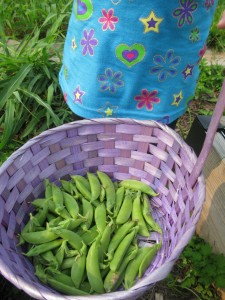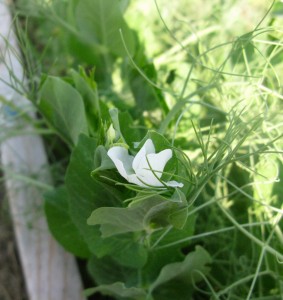My Current Favorite Vegetable Variety: Cascadia Snap Peas
While herbicide contamination in commercial compost seems to have stunted many of my plants, it hasn’t stopped my six raised beds at the Westside Community Garden from producing decent crops.
Many of my radish plants have stunted, twisted roots, but I do have a big beet ready to pull from the ground, and other beets coming along slowly, but surely. My purple baby bok choy have taken months to grow to the height of three inches–which is weeks slower than they should be, but my purple mizuna is huge and beautiful. My tomato plants are covered with blooms and fruit, and
even my poor, sad eight-inch tall haricot vert plants are blooming wildly and producing harvestable beans.
And my lettuce patch has yielded four huge harvests so far and is still going strong, while the Slow Bolt cilantro is living up to its name and is producing a weekly harvest of flavorful green leaves and stems.
So all is not lost, not by a long shot. I consider my disappointing experience with bagged commercial manure and compost to be a learning opportunity, and have filed the data I have learned from it away in my memory banks, (and garden journal!) to be used for seasons long after this one.
My favorite surprise vegetable success this year is sugar snap peas.
To be specific, “Cascadia” sugar snap peas.
My Grandpa complained about how hard peas were to grow in the garden, and many home gardeners find peas to be a lot of work, and that they take up a lot of space for a very small harvest.
Cascadia, however, has surprised me with it’s prolific nature.
Kat and I first harvested it a couple of weeks ago, and while we worked, I noted that there were plenty of blossoms left on the plant, so I didn’t do what my Grandpa always did–after he harvested peas, he pulled them up and gave the vines to the cows to eat (I’d have composted the vines, having no cows to feed), and planted something new there. I figured–“let’s see how many peas we get from this second flush of blossoms.”
Anyway, we picked a generous quart off of the plants intensively planted in three square feet of space. Even though the vines are 1/3 smaller than they should be–they are only about two feet tall rather than three–they still produced a massive amount of pods, though some were a bit undersized–just as the vines were.
So, last week, on Sunday, Kat and Zak and I were thrilled to find another bunch of peas dangling from the vines. We picked those and got about 3/4 of a quart. There were one or two blossoms left and I thought I might pull them, but then decided not to, because Kat wanted to go home and it was starting to rain, and thunder was rumbling in the distance.
Imagine my surprise today, just THREE days later, when I showed up at the garden, ready to pull peas and plant broccoli raab seeds, to find the vines covered with a third flush of beautiful white blossoms! And when I say covered, I swear this third wave of blooms has more flowers on it than the other two combined.
And, on top of all of this, the peas are sweet, crisp and juicy. Eaten raw, they are sugary without a hint of the bitterness that sometimes comes accompanies raw peas, and when cooked they are sublime.
So, needless to say, next year, I’m planting Cascadia again, (and more than just three square feet of them, too) and I highly suggest that any other sugar snap pea lovers among you do the exact same. Even under the worst conditions, this variety really produces amazingly well.
2 Comments
RSS feed for comments on this post.
Sorry, the comment form is closed at this time.
Powered by WordPress. Graphics by Zak Kramer.
Design update by Daniel Trout.
Entries and comments feeds.





I live on the Pacific coast and our summers are cold and foggy. Snap peas (I don’t think they were Cascadia) have been my most reliable garden plant. They grow, produce peas, my 3yo picks them and eats them off the vine. We have them almost all summer and then we can plant again. I’ve given up on tomatoes because of our climate but peas we can do year-round, really.
Comment by Kim — June 22, 2011 #
Where my parents live (Northern CA) we leave the pea vines in from early spring until high summer, when they finally start to dry out and go a little sad. 🙂
Comment by annoyedwabbit — June 23, 2011 #